09 March 2024: Database Analysis
Bibliometric Insights Into the Evolution of Atrial Fibrillation and Dementia Research 2002–2022
Yu Zhao1ABCDEF, Dianbo Wang1AF*DOI: 10.12659/MSM.943239
Med Sci Monit 2024; 30:e943239
Abstract
BACKGROUND: In response to the escalating prevalence of atrial fibrillation (AF) and its potential correlation with cognitive impairment and dementia, we conducted a comprehensive bibliometric analysis to assess current research trends, contributors, and collaborative networks in this evolving interdisciplinary field.
MATERIAL AND METHODS: Articles published between 2002 and 2022 were extracted from the Web of Science database and carefully screened, yielding 328 publications. Two reviewers independently conducted the screening and quality appraisal. We employed sophisticated tools such as CiteSpace, VOSviewer, and Bibliometrix (R-Studio’s R tool) to succinctly summarize and thoroughly analyze the publications.
RESULTS: A total of 328 publications, comprising 262 papers and 66 reviews, were included in the final analysis. The number of publications exhibited a consistent year-on-year increase, demonstrating an average annual growth rate of 20.57%. These publications originated from 41 countries and regions, with the highest contributions observed from the United States, United Kingdom, Italy, and China. Notably, the University of Liverpool emerged as the most prolific institution, while the most prolific author was Lip GYH from the United Kingdom. The journal with the most publications is the journal of the American Heart Association (19 articles). The most popular keywords in order were: risk and stroke (n=101), dementia (n=100), decline (n=70), prevalence (n=67), and Alzheimer’s disease.
CONCLUSIONS: This study shows the current research status and emerging trends in atrial fibrillation’s link to dementia and cognitive impairment. It highlights global growth and collaboration patterns while offering a comprehensive view of their interrelationship, pointing toward future research directions.
Keywords: Alzheimer Disease, Atrial Fibrillation, cognitive dysfunction, Dementia
Background
Atrial fibrillation (AF) is the prevailing form of arrhythmia in contemporary times, characterized not only by its high incidence but also by a year-on-year increase. Epidemiological studies have demonstrated prevalence rates ranging from 0.4% to 1% in population-based investigations, and a higher prevalence rate of 2.14% to 8% in hospital-based studies [1], particularly among individuals aged 80 years and above [2–4]. Projections indicate that by 2030, the estimated prevalence of AF will reach 12 million in the United States, and by 2060, it will escalate to 17.9 million in European countries [1,5,6]. This cardiac condition profoundly impacts patient longevity and exerts a substantial burden on global healthcare systems. This disease is characterized by rapid, irregular atrial contractions, leading to diminished cardiac output and symptoms like palpitations and dizziness [7]. It also increases the risk of thrombotic events, such as strokes, due to heightened blood clot formation [8,9], and this further increases the development of coronary heart disease [10]. Research has elucidated a significant association between AF and endothelial dysfunction, establishing it as a potential risk factor for the onset of coronary heart disease [11]. In turn, the progression of coronary heart disease plays a contributory role in the development of atrial fibrillation [12,13]. Patients with myocardial infarction have increased risk of death whether AF was diagnosed before (OR: 1.28) or at the time (OR: 1.37) of the myocardial infarction [14]. Therefore, studies indicate a strong correlation between AF and psychiatric/neurological disorders, including dementia and depression [15–19].
Dementia, involving the decline in cognitive domains like memory and language [20], affects over 5% of those aged 65 and above globally [21], with mild cognitive impairment reaching 11% in China [22]. Alzheimer’s disease (AD) is the leading cause, constituting 60–80% of cases [23,24], and 40–60% of individuals aged 58 and older with mild cognitive impairment have underlying AD pathology [25]. AD manifests as neurodegenerative alterations in the brain, including the presence of amyloid deposits and neurofibrillary tangles [26,27]. Besides age, genetics, and lifestyle, stroke and cardiovascular disease are emerging as crucial risk factors for both vascular dementia and AD [28–30]. Notably, AF, a representative cardiovascular condition, has been identified as a risk factor for dementia and AD [31,32]. AF and AD are 2 prevalent and debilitating health conditions that pose significant challenges to public health globally.
Given the association between AF and dementia or cognitive impairment, a bibliometric analysis of the existing literature becomes imperative. Bibliometrics, an established discipline since 1969, systematically evaluates scholarly output to identify trends, contributors, influential journals, and research themes [33–36]. Therefore, the primary objective of this study was to conduct a rigorous bibliometric analysis of AF and dementia or cognitive impairment publications, aiming to provide comprehensive insights into the present research landscape, prevailing trends, and research priorities within this domain. Such knowledge will enhance understanding of the intricate relationship between AF and dementia or cognitive impairment, while also providing valuable guidance for future research directions, clinical practices, and evidence-based decision-making endeavors.
Material and Methods
DATA SOURCE AND SEARCH STRATEGIES:
The literature used in this study was sourced from the Web of Science Core Collection (WoSCC), one of the most comprehensive and authoritative database platforms in the world [37]. The search period was from January 1, 2002 to December 31, 2022. In present study, the search strategy was set as the following: TS=(“atrial fibrillation” OR “AF”) AND TS=(“cognitive impairment” OR “cognitive dysfunction” OR “dementia” OR “Alzheimer’s disease”), and 1628 records were obtained. Only “Article” and “Review” were selected as article types, and the language was limited to English; 1349 records were finally obtained (Figure 1). The results were exported as plain text files in txt formats. All data searched were exported and saved in plain text format, including title, author, keywords, source, abstract, and references. All these article records were downloaded on the same day (May 25, 2023) to avoid the bias caused by frequent database updates.
DATA COLLECTION AND EXTRACTION:
The literature materials underwent a meticulous screening process conducted by a team of 2 reviewers, who scrutinized the titles and abstracts to eliminate articles that deviated from the designated topic. In cases where necessary, a thorough examination of the full text was conducted for further screening. After excluding publications unrelated to the topic, as well as other types such as case studies, book chapters, and theses, along with publications from different domains (Figure 1), a total of 328 articles were ultimately considered eligible and included in the final study. The downloaded records encompassed comprehensive information, including details such as the title, authorship, publication details, age considerations, geographic origins, influential factors, references, and other relevant attributes.
DATA ANALYSIS AND VISUALIZATION:
The compiled txt files were imported into the online analysis platform (http://bibliometric.com/) for visualization and analysis of country partnerships and publication volume. The “bibliometrix” package of R software was employed to analyze all relevant information encompassing sources, countries, citations, world maps, institutions, authors, journals, and keywords [38]. Additionally, VOSviewer, developed by Leiden University in the Netherlands, was utilized to extract and analyze data on cooperation, keyword co-occurrence, co-citation, and other pertinent information [39]. In this study, we utilized the VOSviewer 1.6.17 software to construct a network diagram, which facilitated a comprehensive visual analysis of authors, institutions, national collaborations, and keyword co-occurrence. The nodes within the diagram represent various information, including temporal aspects, country/region affiliations, institutional associations, authors, keywords, and cited references. Node size is determined by the weight of the respective element, such as publication count, citation count, or frequency of occurrence. Each node is assigned a distinct color, wherein nodes sharing the same color belong to the same cluster. The connections between nodes reflect the correlations between the elements. The thickness of the links denotes the strength of their association, with thicker links representing stronger connections. Furthermore, to enhance the visual clarity of the network visualization produced by VOSviewer, we employed Pajek, an advanced and freely available software developed by Vladimir Batagel et al, for optimization purposes [40].
CiteSpace, developed by Professor Chen Chaomei at Drexel University, is a widely used tool in bibliometric analysis [41,42]. In this study, we used CiteSpace (version 6.2. R3) to conduct a comprehensive bibliometric and visual knowledge graph analysis encompassing various dimensions, including authors, journals, co-citation references, and keyword burst detection.
Results
OVERVIEW OF THE NUMBER OF PUBLICATIONS:
Based on the defined search criteria, a comprehensive selection process resulted in the inclusion of a total of 328 papers originating from 41 countries, constituting the final dataset for this study. Among these, 262 were articles, while the remaining 66 were reviews. Notably, original papers constituted the predominant proportion of the included publications. A visual representation of the global publication trends, depicted in Figure 2A as a circular bar chart, highlights a consistent year-on-year increase from 2002 to 2022. The average annual growth rate over this period stood at 20.57%, with the number of publications progressively escalating from zero in 2002 to 58 in 2022, especially in the last 5 years, and the growth was rapid. The fitted curve depicted in Figure 2B illustrates a consistent upward trend in the annual number of articles. The model exhibits a commendable fit, as evidenced by the coefficient of determination (R2) value of 0.913 (Figure 2B). Based on the established trend, it is anticipated that the number of articles will reach 100 by the year 2025.
RESEARCH AREAS AND RELATIONSHIPS:
To date, publications have emanated from a total of 41 countries/regions (Figure 3), with the United States exhibiting the highest volume of published articles (n=107, 20.38%), closely trailed by the United Kingdom (n=55, 10.18%), Italy (n=55, 10.18%), China (n=43, 8.19%), and Australia (n=27, 5.14%). Collectively, these countries account for more than half of the overall publication count (54.67%). Regarding the number of cited articles, the United States significantly outpaced other nations, with a tally of 4192, while Italy held the second position with 1718 citations (Table 1). In the examination of global collaboration networks, depicted in Figure 2C, 2D, it becomes evident that inter-country/region cooperation is prevalent, with collaborative networks predominantly concentrated in North America, Western Europe, Australia, and East Asia. Notably, the United States maintains a dominant position in terms of the H-index of publications in this field (H-index=43), establishing itself as a prominent force. Following suit are the United Kingdom, Italy, China, and Australia, substantiating the pivotal roles played by these 5 countries in the advancement of research and development within this domain.
INSTITUTION AND AUTHOR DISTRIBUTION:
These publications stem from a total of 665 distinct institutions, with the top 10 institutions possessing the highest publication counts, outlined in Table 2. Topping the list is the University of Liverpool, contributing 20 articles, closely followed by the Karolinska Institute with 18 articles. Additionally, the Liverpool Heart and Chest Hospital accounted for 15 articles, the Intermountain Medical Center for 14 articles, and McMaster University for 12 articles (Figure 3A). Notably, out of the top 10 institutions, 5 are based in the United States, while the United Kingdom is represented by 2 institutions. Regrettably, Chinese institutions do not feature in this list. In regard to citation frequency, Boston University emerges as the leading institution with the highest count of citations (n=961 articles), closely followed by the Intermountain Medical Center (n=589 articles) (Figure 3A). Furthermore, Boston University garners the highest average citation volume among the institutions analyzed. Notably, both of these prominent institutions hail from the United States. The visualization of the collaboration network diagram, generated by VOSviewer, illuminates the close partnerships fostered among organizations across various countries and regions. Particularly noteworthy is the prominent central positioning of the University of Liverpool and the Karolinska Institute within the collaboration network (Figure 3B).
Regarding the authors of the publications, Table 3 presents the top 10 authors along with their citation counts and author information. Notably, the top 10 authors collectively contributed 142 articles, representing approximately 43.29% of the overall publication volume. Among them, Lip GYH from the United Kingdom attained the highest publication count with 26 articles, closely followed by Bunch TJ with 23 articles, Jacobs V with 15 articles, and May HT with 13 articles. It is noteworthy that 9 out of the top 10 authors originated from the United States, with 3 authors affiliated with the Intermountain Medical Center. This observation underscores the frequent collaborations and close ties among authors from the same country or organization, suggesting their research has laid a foundational impact on the field at large. Visualization of collaborative network graphs of different authors is shown by VOSviewer I Figure 3C. Remarkably, Bunch TJ emerged as the most cited author with 1061 citations, trailed by Day JD with 913 citations, May HT with 912 citations, and Lip GYH with 767 citations, as illustrated in Figure 3D.
JOURNALS:
The analysis of journals reveals that the 328 publications originate from a diverse range of 156 journals. Table 4 presents detailed information on the top 15 journals based on their publication contributions. Furthermore, Figure 4A demonstrates that the distribution of these significant journals aligns with Bradford’s literature dispersion law, affirming its applicability in this context. The Journal of the American Heart Association claims the highest number of publications (n=19), serving as the official journal of the American Heart Association. Figure 4B illustrates the annual publication trend of this journal, demonstrating a substantial increase in article output since 2018. Following suit, the next most prominent journals include the Journal of Alzheimer’s Disease (n=12), Stroke (n=10), and the Journal of the American Genetics Society (n=9) (Figure 4C). It is notable that these journals primarily focus on the domains of cardiovascular diseases and nervous system disorders. Additionally, while the European Heart Journal may not possess the highest article count, it holds the distinction of having the largest impact factor and the highest number of cited articles (Figure 4D).
Furthermore, it is noteworthy that most of the top 15 journals hold Q1 or Q2 rankings, signifying their substantial influence within the field. This observation underscores the heightened attention and acceptance bestowed upon this particular research direction. Employing VOSviewer to visualize the interconnections between journals, we used clustering techniques to group the 156 journals into 7 distinct categories. The representative red-colored cluster predominantly focuses on geriatrics and neurological diseases, while the blue-colored cluster centers around cardiovascular and thrombotic diseases. The remaining clusters encompass integrative, geriatric, and therapeutic aspects (Figure 5A). Based on the co-cited frequency, these journals are classified into 5 clusters, the red section predominantly centers on the domain of nervous system disease, while the green section primarily encompasses cardiovascular diseases and comprehensive medical journals. The blue segment is chiefly devoted to the field of neural basis, and the remaining portions concentrate on various aspects of cardiovascular diseases (Figure 5B).
The dual-map overlay of academic journals provides a comprehensive visualization of the distribution of topics, evolution of citation trajectories, and the shifting research centers within the scholarly landscape. As depicted in Figure 5C, the left side predominantly represents the journals cited, whereas the right side primarily represents the journals that publish articles. The cited journals encompass various subjects, including MEDICINE, MEDICAL, CLINCIAL, PSYCHOLOGY, EDUCATION, and HEALTH. On the other hand, the journals publishing articles encompass topics such as MOLECULAR, BIOLOGY, GENETICS, HEALTH, NURSING, and MEDICINE.
HIGHLY CITED PAPERS:
Through our analysis of highly cited papers within this research field, we identified 54 articles that have accumulated more than 50 citations, with the top 10 papers amassing a total of 2516 citations (Table 5). Notably, Professor Staerk L’s “Atrial Fibrillation: Epidemiology, Pathophysiology, and Clinical Outcomes” stands as the most cited article (n=515). Following closely is Professor Kalantarian S’s “Association of Impaired Atrial Function with Atrial Fibrillation: A Meta-analysis,” which not only boasts a remarkable citation count but also holds the distinction of having the highest impact factor (IF=16.104). Among the top 10 articles, Professor Bunch TJ contributed 2 notable publications, accumulating a combined total of 525 citations. Undoubtedly, these top 10 articles have significantly contributed to laying the foundation for research within this field.
KEYWORD AND HOTSPOT ANALYSIS:
The analysis of keywords serves as a pivotal component of this article, as it not only elucidates the article’s topic but also unveils the field’s developmental trajectory. From a corpus of 328 papers, we extracted 1020 core keywords. Figure 6A highlights the top 10 keywords with the highest frequency, indicating that “risk” and “stroke” (n=101) are the most frequently occurring keywords, followed by “dementia” (n=100), “decline” (n=70), “prevalence” (n=67), and “Alzheimer’s disease” (n=58). In terms of temporal variation (Figure 6B), all core keywords have exhibited a significant increase since 2017, paralleling the surge in publication volume. Notably, “risk,” “stroke,” and “dementia” have emerged as prominent research focal points, as corroborated by the word cloud depicted in Figure 7A. Collectively, these core keywords form the foundation of this research area and represent the primary research directions within the field.
The keyword co-occurrence network was visualized through VOSviewer. Circles and labels form nodes, with circle size positively correlated with keyword frequency and circle line thickness positively correlated with the strength of relationships between keywords. Nodes of different colors form different clusters, with each color representing a distinct research direction, divided into 3 clusters. The green clusters predominantly align with the domain of nervous system diseases, encompassing subjects such as AD, cognitive impairment, depression, diagnostic methodologies, and interventions for nervous system diseases. Within the red cluster, emphasis is placed on the treatment and risk factors associated with cardiovascular diseases, including stroke, risk assessment, warfarin usage, dementia, association analyses, population-based studies, mobility assessment, and compensatory mechanisms. The blue cluster centers on exploring and analyzing potential mechanisms within the research field, focusing on risk factors, long-term risks, incident dementia, catheter associations, and C-reactive protein analysis, among others. Notably, the key risk factors encompass disease-related risks and small-vessel factors. These 3 clusters collectively encompass the entirety of the research field, providing comprehensive coverage of the subject matter (Figure 7B).
We utilized CiteSpace to cluster and visualize keywords, as depicted in Figure 7C, showing a timeline view of keyword clustering. Within this visualization, keywords belonging to the same cluster are arranged chronologically from left to right along a horizontal axis, with the rightmost position representing the most recent time node. The analysis yielded a network comprising 404 nodes and 2634 connections, with a density of 0.0324. Eight distinct clusters were identified, encompassing the following themes: #0 oral anticoagulation treatment, #1 vascular factor, #2 silico investigation, #3 prestroke dementia, #4 death stroke, #5 oral anticoagulant, #6 atrial cardiopathy, and #7 hemostatic function. Clusters #1, #2, #5, and #7 emerged as the initial clusters in this analysis. Research pertaining to clusters #1, #2, and #3 has ceased, while the remaining 5 clusters continue to be active, signifying ongoing research pursuits. Notably, the earlier keywords found within cluster #1, such as “therapy”, “stroke prevention”, and “warfarin”, demonstrate a broader temporal span, underscoring their significance as focal points within this field of study. These cluster markers have established themselves as crucial research topics, solidifying a consistent and enduring research direction in this domain. In addition, keywords such as artificial intelligence and alpha synuclein are currently emerging research directions. Furthermore, we utilized CiteSpace’s robust citation burst feature to identify and analyze keywords, thereby investigating emerging areas in the research on AF and dementia, as depicted in Figure 7D. The blue line represents the timeline, while the red segments along the blue timeline indicate the burst detection, signifying the commencement year, termination year, and duration of each burst. The keywords with strongest citation bursts were “cerebral infarction (2007–2014), meta-analysis (2014–2016), apolipoprotein-e (2007–2014)”, The most recent burst keyword included “epidemiology (2019–2022), outcome (2019–2022), and systematic review (2021–2022)”.
Discussion
In recent years, AF, being one of the most prevalent arrhythmias, has garnered growing attention within the realm of research on nervous system disease, particularly its association with dementia, cognitive impairment, and dementia [43]. This bibliometric analysis spanning 2 decades reveals a consistent upward trend in published papers, with an average annual growth rate of 20.57%. Notably, the publication output doubled from 18 in 2017 to 35 in 2018, indicating a heightened interest in and significance of the field. Upon analysis, several factors contribute to the observed trend. Firstly, it is plausible that the advancement of healthcare systems and the deepening understanding of the nervous and mental systems have significantly increased people’s attention to these domains. Secondly, researchers and medical professionals have progressively acknowledged the relationship between AF and dementia, prompting heightened interest in this area. Furthermore, the escalating incidence rates of both conditions have further propelled research advancements in this field [44–46]. The sustained growth in the number of publications in recent years suggests that AF and dementia may emerge as prominent research focal points and future directions.
The examination of publication regions and their interconnections offers valuable insights into collaborative networks within the research field. The bibliometric analysis of AF research reveals the consistent prominence of the United States as the country with the highest publication count in this domain [47]. Among the 328 publications analyzed in this study, the findings indicate a notable dominance of Europe and the United States in terms of publication count, citations, H-index, and other key indicators. These outcomes elucidate the significant influence of these nations on research and development within this domain, underscoring their pivotal role in shaping advancements and progress in this field. Furthermore, it is important to note that the level of attention dedicated to this domain within a particular country is also influenced by its own national circumstances. By the year 2025, the elderly population aged 60 and above in China is projected to reach 280 million, comprising approximately one-fifth of the total population [48]. Similarly, by the year 2030, the elderly population aged 65 and above in the United States is also expected to account for approximately one-fifth of the total population [49]. Furthermore, it is anticipated that the population affected by Alzheimer’s disease and cognitive impairment in the United States will reach 13.9 million by the year 2060 [50], and it has become the sixth leading cause of death in the United States [45]. Similarly, an analogous situation is observed in developing nations. A study conducted in China revealed that the overall prevalence of dementia among individuals aged 60 years and above was 5.30% [51]. The number of patients with dementia in China accounts for approximately 25% of the entire population with dementia worldwide [51]. In India, a study reported dementia in 37% of all patients diagnosed with atrial fibrillation [52]. Such factors contribute to the impetus driving research efforts and investments in AF and dementia within specific countries and regions. Moreover, collaborative endeavors among countries and regions facilitate the exchange of resources, expertise, and diverse perspectives, thereby fostering the emergence of innovative research findings.
The analysis of institutional affiliations plays a crucial role in understanding the organizations that have made notable contributions to research outcomes. Regarding publication output, the University of Liverpool, Caroline College, and Liverpool Hospital of Cardiothoracic Surgery emerge as the top 3 institutions. Notably, most of the top 10 research institutions are situated in the United States and the United Kingdom, highlighting their substantial research productivity. However, the absence of representatives from Chinese institutions in this list underscores an area that warrants attention for future collaboration and research development. It also suggests the potential for Chinese institutions to strengthen international partnerships and augment their influence within this field. The analysis of author publication output reveals that Lip GYH from the UK is not only the most prolific author but also holds the highest publication volume within the domain of AF [47]. It is noteworthy that most of the top 10 authors, in terms of published articles, are in the United States. Additionally, the most frequently cited author is also from the United States, thereby attesting to the influential role of the United States in this field. This could be attributed to several factors, such as a strong research infrastructure, ample funding opportunities, and a collaborative research ecosystem.
Analyzing the journal landscape provides insights into the dissemination of research findings and the influence of specific publications within the field. Notably, the Journal of the American Heart Association and other top-tier publications demonstrate wide acceptance. The European Heart Journal’s high impact factor and citations underscore its importance in publishing impactful research.
Furthermore, the analysis of keywords and identification of research hotspots offer valuable insights into emerging areas and research topics within the field. Key terms such as risk, stroke, dementia, and prevalence provide a foundation for prioritizing research, understanding potential mechanisms, and exploring risk factors. Notably, the term “stroke” emerged as a significant factor in this analysis. While previous studies have indicated that AF serves as a risk factor for dementia or cognitive impairment [53], the role of stroke in this relationship remains a subject of ongoing debate. A meta-analysis demonstrated in patients with AF who suffered a stroke, the risk of developing dementia more than doubled (hazard ratio 2.4) [54]. In addition to the occurrence of noticeable embolic events, there is evidence to suggest that clinically insignificant embolic events in AF may contribute to cognitive decline, doubling the likelihood of asymptomatic cerebral infarction, associated with subsequent stroke and cognitive decline [55–57]. Regarding treatment, early stroke prevention in AF is crucial for mitigating dementia risk [58]. This implies that stroke may play a central role in the development of dementia and cognitive impairment in individuals with AF [59]. However, certain studies have indicated that dementia and cognitive impairment associated with AF are independent of significant cerebrovascular events [60,61]. Hence, it cannot be ruled out that dementia in AF patients may arise from a multifactorial interplay of various factors. A study conducted in Iceland suggests that abnormal hemodynamics resulting from AF, leading to inadequate cerebral perfusion, may be a contributing factor to cognitive impairment [62]. Additionally, several studies propose that decreased carbon dioxide sensitivity in patients with AF [63], along with abnormal carbon dioxide levels in the body, can contribute to microvascular dysfunction and dysautonomia [64]. Furthermore, advanced age [28], genetic susceptibility [65,66], cerebral hypoperfusion [67], inflammation [68–70], and oxidative stress [70] are considered potential factors contributing to the development of dementia and cognitive impairment. Investigating these underlying mechanisms not only sheds light on the interconnectedness of these conditions but also fosters collaborative efforts among various institutions and organizations involved in related research endeavors.
The identification of emerging areas, including novel treatment modalities, biomarkers, and risk stratification, provides valuable insights into current trends and potential future directions in research. Previous studies have demonstrated the significant reduction in dementia risk through treatments such as radiofrequency ablation and warfarin [71–73]. Additionally, recent investigations have revealed that rivaroxaban, by inhibiting PAR-1/PAR-2 in a mouse model of AD+CAA, attenuates neuroinflammation, improves blood-brain barrier function, ameliorates memory deficits, and reduces amyloid-β deposition. These findings highlight the potential of rivaroxaban in slowing the progression of AD [74]. Moreover, additional investigations have reported aberrant serum levels of β-amyloid (Aβ40 and 42) and malondialdehyde (MDA) in individuals with AF who subsequently develop the disorder [75]. The investigations into novel therapeutic modalities, elucidation of new mechanisms, and other related explorations not only establish the trajectory for future research endeavors but also offer researchers and stakeholders the opportunity to identify research gaps, promote collaborative efforts, and propel advancements within the field.
This study conducted a comprehensive bibliometric analysis of the relationship between AF and cognitive impairment or dementia. While providing valuable insights into the current research landscape, it is important to acknowledge the inherent limitations of the study. Although all publications were reviewed, assessing the individual quality of each was challenging. High-quality papers might receive fewer citations, influenced by factors like recency. Relying solely on citation metrics may overlook diverse research impacts. Future studies should include qualitative measures, like peer reviews, to complement bibliometric analysis. Additional databases would enhance comprehensiveness, reflecting the current research state more accurately. Factors like funding, policies, and regional differences were not extensively explored; future research could integrate qualitative methods or additional data sources for a better contextual understanding. In this research domain, there is an imperative need to delve into the underlying mechanisms of both conditions. This exploration can pave the way for the discovery of novel therapeutic drugs, treatment modalities, or preventive measures. Such advancements would not only bridge existing gaps in the field but also significantly enhance current understanding and management of the disease.
Conclusions
In conclusion, the bibliometric analysis of AF and dementia has significantly advanced our comprehensive understanding of this field. The findings derived from this research provide valuable insights into the growth trends and collaborative patterns observed in global studies. Notably, the study identifies leading countries, institutions, and authors, with the United States playing a prominent role. Additionally, it highlights major research domains within this field. These findings serve to inform researchers, policymakers, and stakeholders about the current landscape, enabling them to identify research gaps, foster collaborations, and drive progress in this field. Simultaneously, this analysis further advances our understanding of the intricate association between these 2 diseases, thereby facilitating the development of tailored strategies for the prevention and treatment of cognitive impairment, dementia, and other nervous system disorders. Such targeted interventions hold the potential to alleviate the societal and medical burdens imposed by these conditions, while also charting a clear research trajectory for future investigations.
Figures
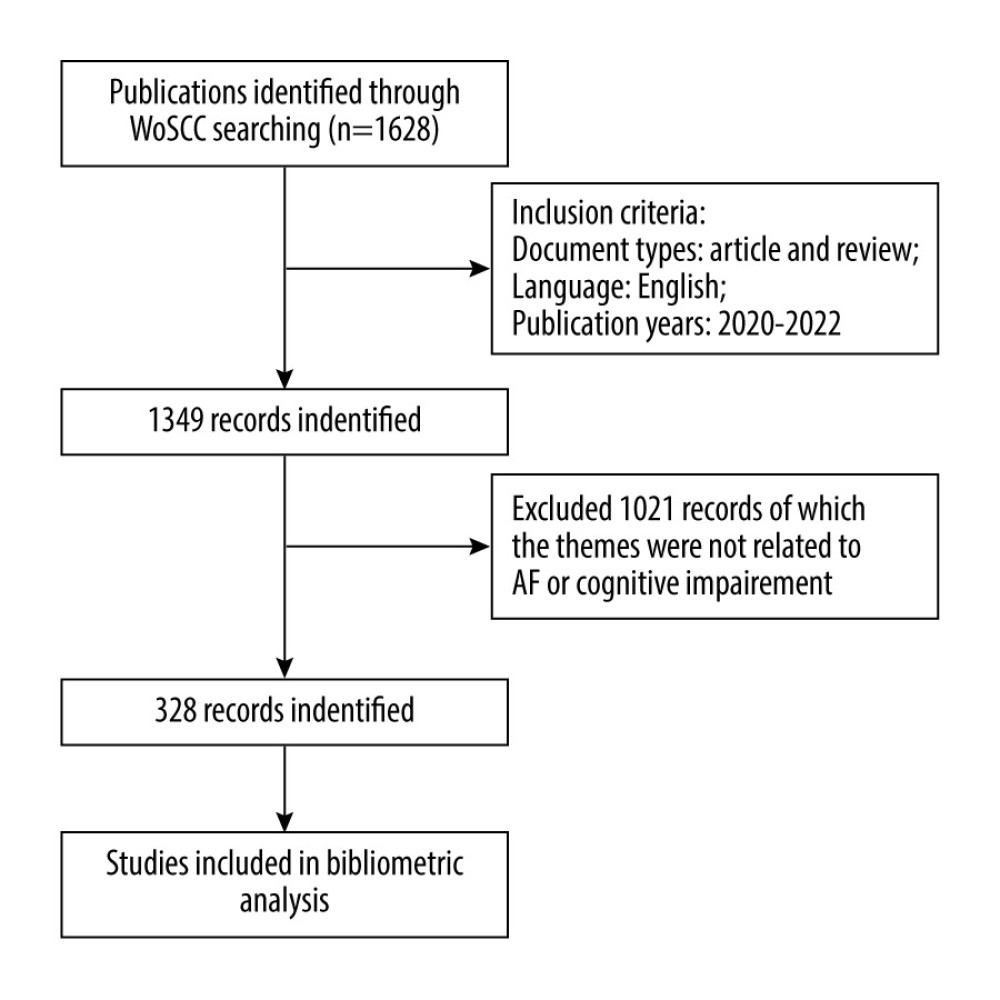 Figure 1. Publication screening flow chart.
Figure 1. Publication screening flow chart. 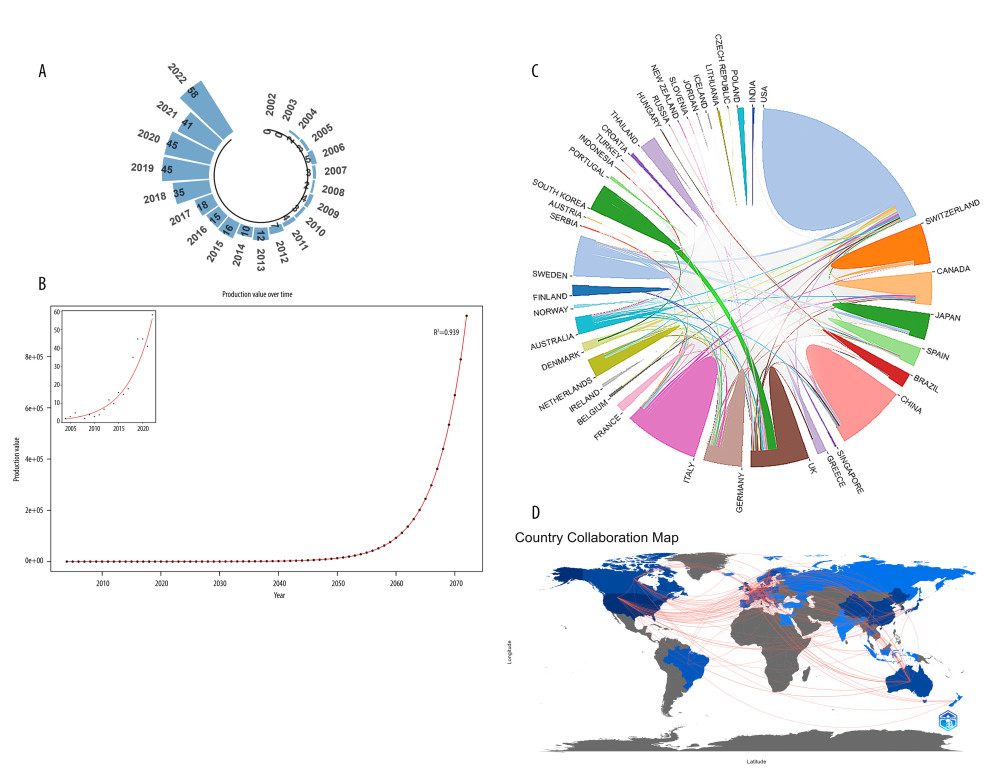 Figure 2. (A) The circular bar chart presents the annual publication count from 2002 to 2022. (B) The trend and fitted curve of the annual publication volume are presented, with R2 representing the coefficient of the model. A higher value of R2 indicates a better fitting effect of the equation. (C) The collaborative network among countries and regions is depicted, where the thickness of the lines denotes the level of collaboration intensity. (D). The geographic visualization map depicts participating countries, with lines symbolizing collaborations between countries and regions, and darker colors indicating higher publication volumes. Figure A was generated using the R (version 4.2.2) package “ggplot2.” Figure C was constructed using an online analysis platform available at http://bibliometric.com/. Figure D was created using the R (version 4.2.2) package “bibliometrix”.
Figure 2. (A) The circular bar chart presents the annual publication count from 2002 to 2022. (B) The trend and fitted curve of the annual publication volume are presented, with R2 representing the coefficient of the model. A higher value of R2 indicates a better fitting effect of the equation. (C) The collaborative network among countries and regions is depicted, where the thickness of the lines denotes the level of collaboration intensity. (D). The geographic visualization map depicts participating countries, with lines symbolizing collaborations between countries and regions, and darker colors indicating higher publication volumes. Figure A was generated using the R (version 4.2.2) package “ggplot2.” Figure C was constructed using an online analysis platform available at http://bibliometric.com/. Figure D was created using the R (version 4.2.2) package “bibliometrix”. 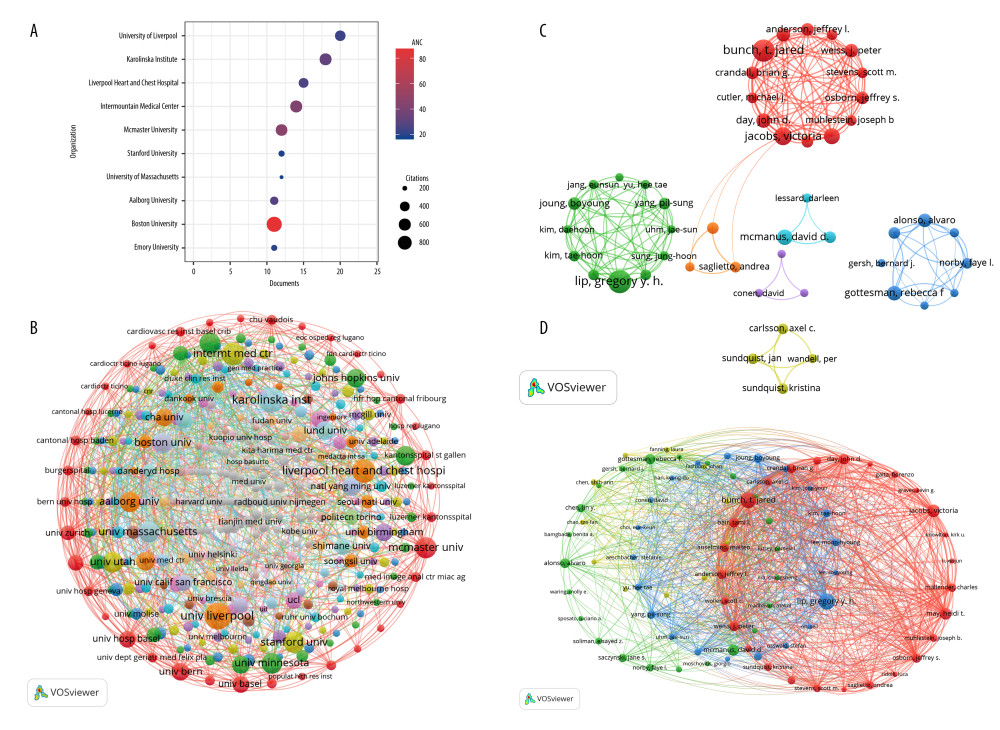 Figure 3. (A) The bubble chart depicts the quantity of publications, citations, and average citations generated by various institutions. (B) Institutional collaboration network. (C) Visualization of Author Collaboration Network Analysis. (D) The analysis of the collaborative network visualization of authors’ citations reveals distinct clusters, with different colors representing each cluster. The size of the nodes corresponds to the frequency of occurrence. Figure A was generated using the R (version 4.2.2) package “ggplot2”. Figures B, C, and D were produced utilizing VOSviewer software (version 1.6.17).
Figure 3. (A) The bubble chart depicts the quantity of publications, citations, and average citations generated by various institutions. (B) Institutional collaboration network. (C) Visualization of Author Collaboration Network Analysis. (D) The analysis of the collaborative network visualization of authors’ citations reveals distinct clusters, with different colors representing each cluster. The size of the nodes corresponds to the frequency of occurrence. Figure A was generated using the R (version 4.2.2) package “ggplot2”. Figures B, C, and D were produced utilizing VOSviewer software (version 1.6.17). 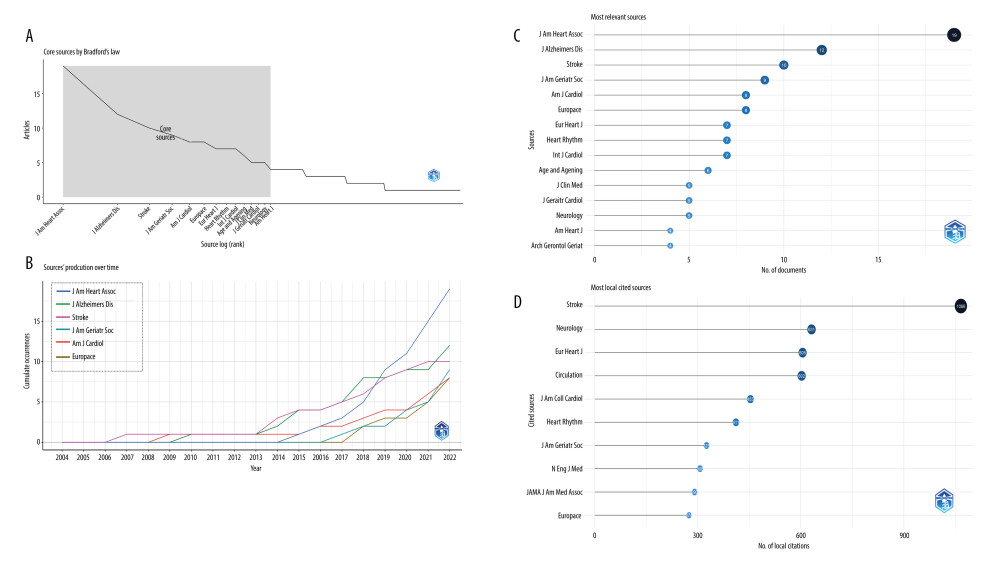 Figure 4. (A) Bradford’s Law for journals involved in AF and AD research. (B) The annual publication volume curve of the top 6 journals with published articles. (C) The number of publications in the top 15 journals. (D) The top 10 most frequently cited journals. The figure was created R (4.2.2) package “bibliometrix.”
Figure 4. (A) Bradford’s Law for journals involved in AF and AD research. (B) The annual publication volume curve of the top 6 journals with published articles. (C) The number of publications in the top 15 journals. (D) The top 10 most frequently cited journals. The figure was created R (4.2.2) package “bibliometrix.” 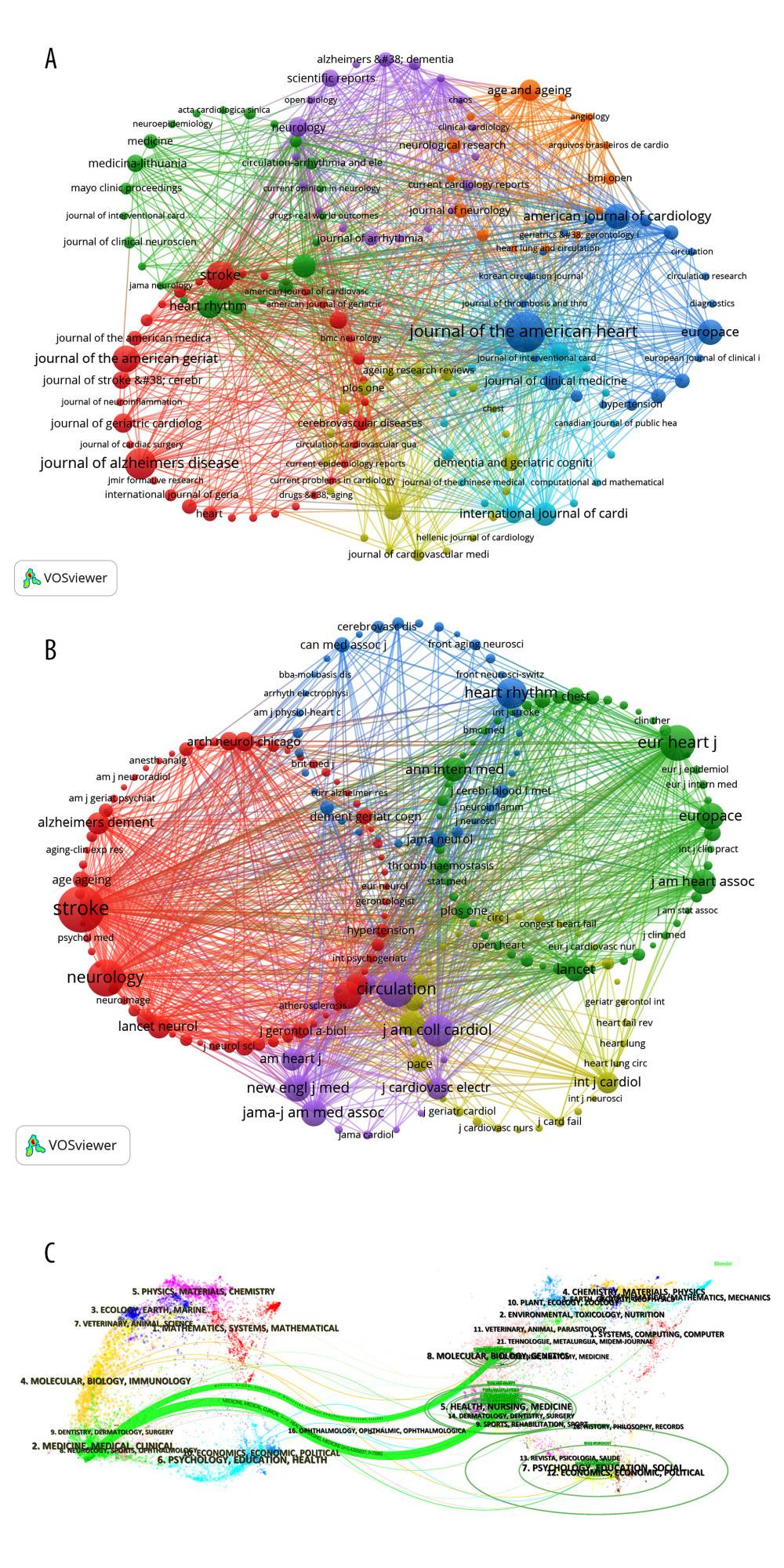 Figure 5. (A) The collaborative network of journals was visualized using VOSviewer for analysis. The nodes, represented by different colors, correspond to journals belonging to distinct clusters, with node size indicating their frequency of occurrence. (B) Analysis of collaborative network visualization of journals’ citations in VOSviewer. The size of the nodes indicates the frequency of their occurrence. (C). The dual-map overlay of journals on research of AF and dementia. Figures A and B were generated using VOSviewer software (version 1.6.17), while Figure C was constructed using CiteSpace software (version 6.2. R3).
Figure 5. (A) The collaborative network of journals was visualized using VOSviewer for analysis. The nodes, represented by different colors, correspond to journals belonging to distinct clusters, with node size indicating their frequency of occurrence. (B) Analysis of collaborative network visualization of journals’ citations in VOSviewer. The size of the nodes indicates the frequency of their occurrence. (C). The dual-map overlay of journals on research of AF and dementia. Figures A and B were generated using VOSviewer software (version 1.6.17), while Figure C was constructed using CiteSpace software (version 6.2. R3). 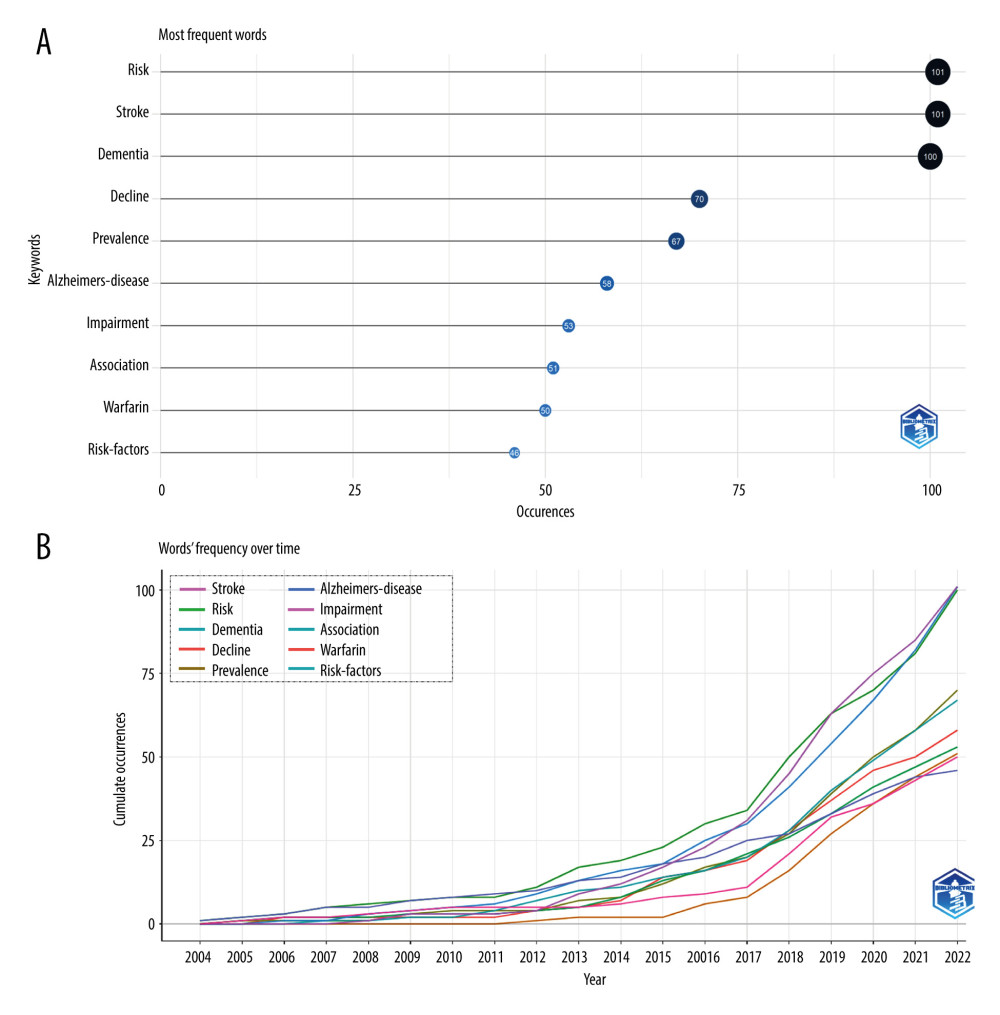 Figure 6. (A) The top 10 keywords with the highest frequency. (B) The run chart depicting the annual cumulative changes in the frequency of high-frequency keywords. The figure was created R (4.2.2) package “bibliometrix.”
Figure 6. (A) The top 10 keywords with the highest frequency. (B) The run chart depicting the annual cumulative changes in the frequency of high-frequency keywords. The figure was created R (4.2.2) package “bibliometrix.” 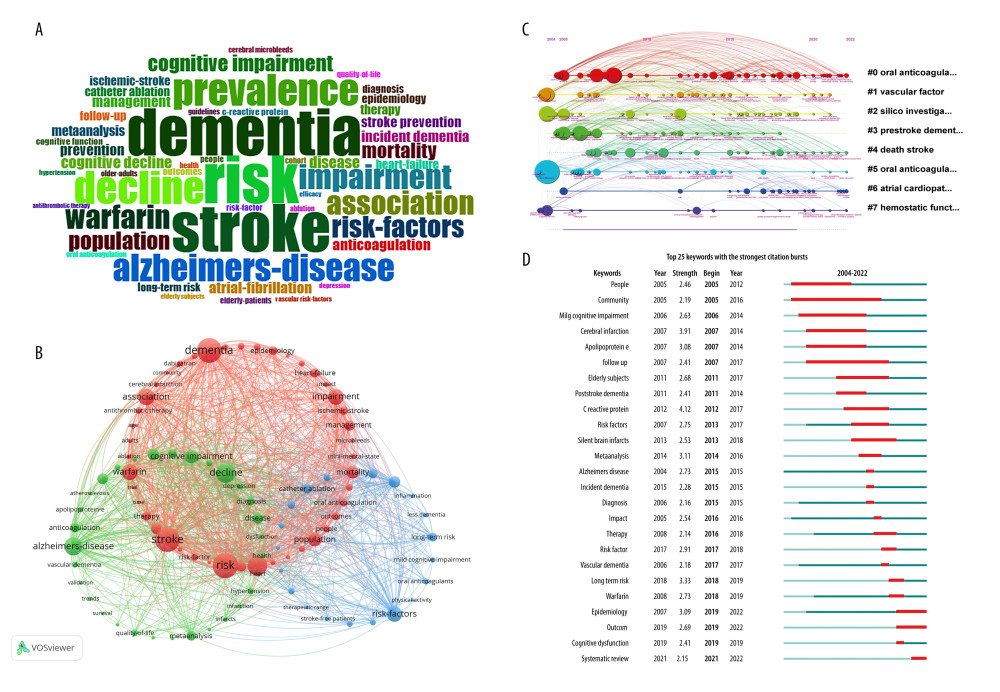 Figure 7. (A) Loud graph of high-frequency keywords. (B) Keyword visualization network. The nodes in different colors represent the different clusters, and the size of the nodes indicates the frequency of their occurrence. (C) Timeline view of keywords. The different colored horizontal lines with the label on the right represent the clusters formed by the keywords, the nodes on the horizontal lines represent the keywords, and the position of the nodes on the horizontal lines represents the year in which the literature containing the keywords first appeared, thus forming the timeline of the keywords cluster evolution. (D) The top 25 keywords with the strongest citation bursts. Figure A was created using the “bibliometrix” package in R (version 4.2.2), Figures B and C were constructed using VOSviewer software (version 1.6.17), and Figure D was generated using CiteSpace software (version 6.2. R3).
Figure 7. (A) Loud graph of high-frequency keywords. (B) Keyword visualization network. The nodes in different colors represent the different clusters, and the size of the nodes indicates the frequency of their occurrence. (C) Timeline view of keywords. The different colored horizontal lines with the label on the right represent the clusters formed by the keywords, the nodes on the horizontal lines represent the keywords, and the position of the nodes on the horizontal lines represents the year in which the literature containing the keywords first appeared, thus forming the timeline of the keywords cluster evolution. (D) The top 25 keywords with the strongest citation bursts. Figure A was created using the “bibliometrix” package in R (version 4.2.2), Figures B and C were constructed using VOSviewer software (version 1.6.17), and Figure D was generated using CiteSpace software (version 6.2. R3). Tables
Table 1. The top 5 productive countries in the field.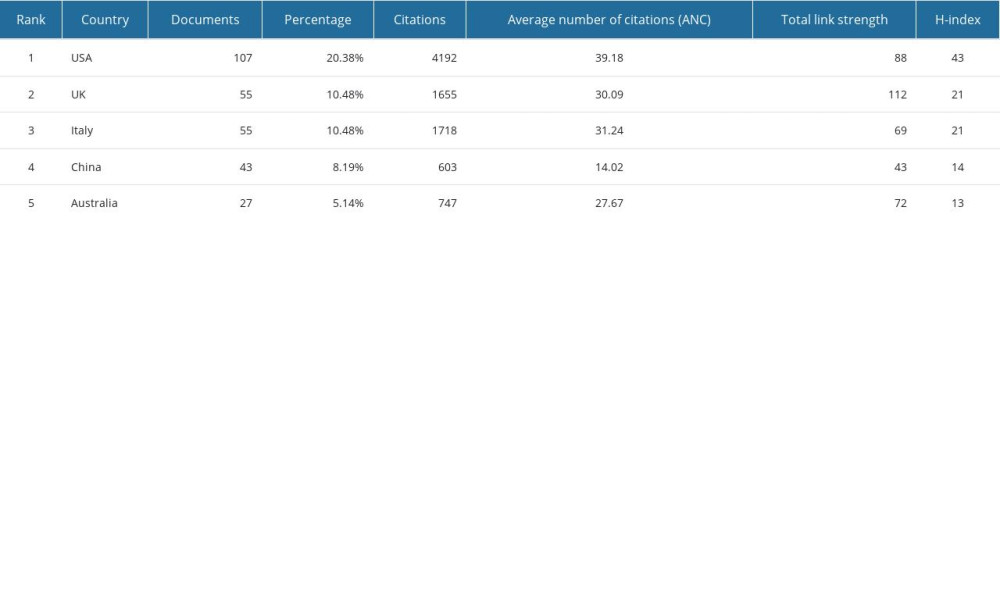 Table 2. The top 10 institutions that contributed to the publications.
Table 2. The top 10 institutions that contributed to the publications.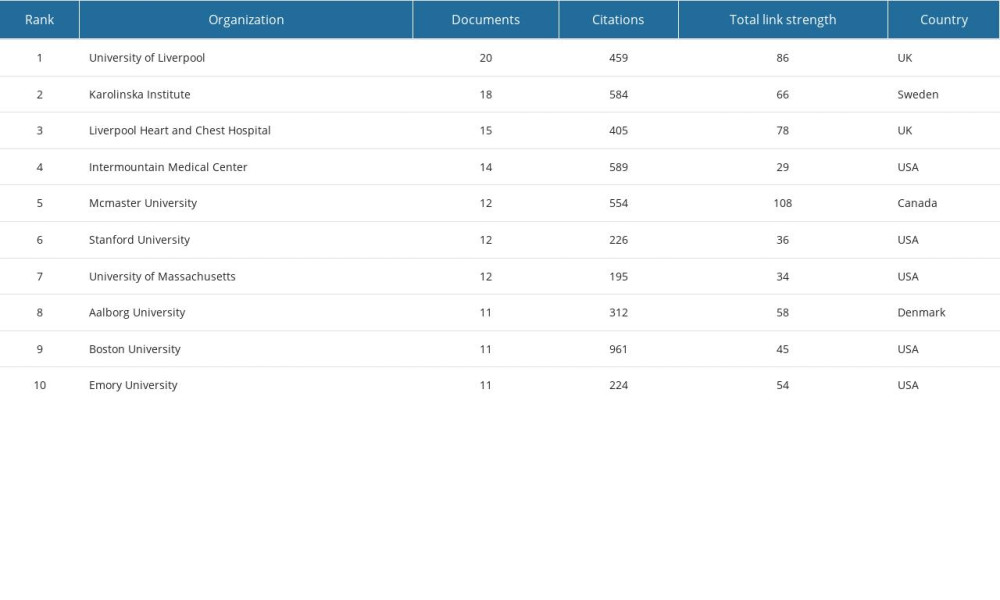 Table 3. The top 10 authors with the most publications on AF associated with dementia.
Table 3. The top 10 authors with the most publications on AF associated with dementia.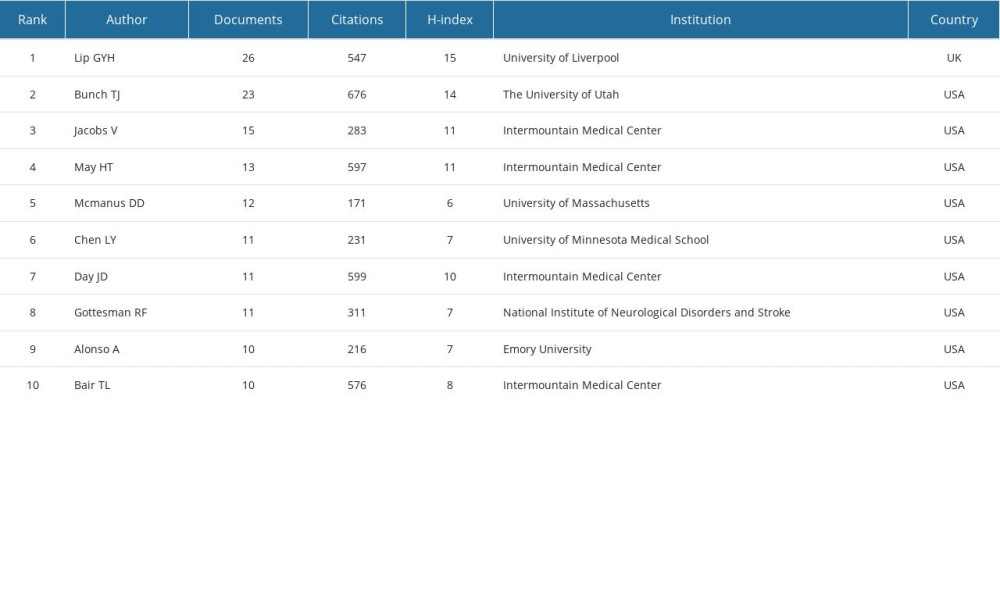 Table 4. Top 15 journals with most publications in the field.
Table 4. Top 15 journals with most publications in the field.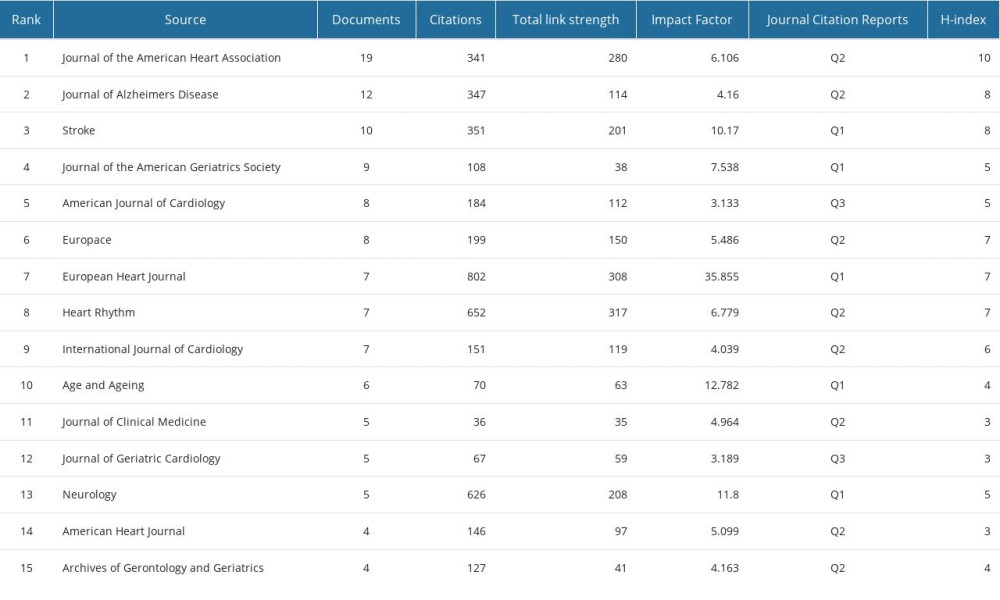 Table 5. Top 10 highly cited references.
Table 5. Top 10 highly cited references.
References
1. Karamitanha F, Ahmadi F, Fallahabadi H, Difference between various countries in mortality and incidence rate of the atrial fibrillation based on human development index in worldwide: Data from global burden of disease 2010–2019: Curr Probl Cardiol, 2023; 48; 101438
2. Piccini JP, Hammill BG, Sinner MF, Incidence and prevalence of atrial fibrillation and associated mortality among medicare beneficiaries: 1993–2007: Circulation, 2012; 5; 85-93
3. Heeringa J, van der Kuip DAM, Hofman A, Prevalence, incidence and lifetime risk of atrial fibrillation: the Rotterdam study: Eur Heart J, 2006; 27; 949-53
4. Chugh SS, Havmoeller R, Narayanan K, Worldwide epidemiology of atrial fibrillation: A global burden of disease 2010 study: Circulation, 2014; 129; 837-47
5. Lippi G, Sanchis-Gomar F, Cervellin G, Global epidemiology of atrial fibrillation: An increasing epidemic and public health challenge: Int J Stroke, 2021; 16; 217-21
6. Schnabel RB, Yin X, Gona P, Larson MG, 50 year trends in atrial fibrillation prevalence, incidence, risk factors, and mortality in the Framingham Heart Study: A cohort study: Lancet, 2015; 386; 154-62
7. Heidt ST, Kratz A, Najarian K, Symptoms in atrial fibrillation: A contemporary review and future directions: J Atr Fibrillation, 2016; 9; 1422
8. Gage BF, Stroke prediction rules in atrial fibrillation: J Am Coll Cardiol, 2018; 71; 133-34
9. Rosano G, Savarese G, Inter-twinned relationship between heart failure and atrial fibrillation: Heart, 2020; 106; 1125-26
10. Al-Makhamreh HK, Al-Sabbagh MQ, Shaban AE, Prevalence, epidemiological characteristics, and pharmacotherapy of coronary artery disease among patients with atrial fibrillation: Data from Jo-Fib study: Medicina (Kaunas), 2021; 57(6); 605
11. Corban MT, Toya T, Ahmad A, Atrial fibrillation and endothelial dysfunction: A potential link?: Mayo Clinic Proc, 2021; 96(6); 1609-21
12. Yang WY, Lip GYH, Sun ZJ, Implications of new-onset atrial fibrillation on in-hospital and long-term prognosis of patients with acute myocardial infarction: A report from the CBD bank study: Front Cardiovasc Med, 2022; 9; 979546
13. Elshaer F, Alsaeed AH, Alfehaid SN, Incidence, clinical predictors, and clinical effect of new-onset atrial fibrillation in myocardial infarction patients: Saudi Med J, 2022; 43(8); 933-40
14. Jabre P, Roger VL, Murad MH, Chamberlain AM, Mortality associated with atrial fibrillation in patients with myocardial infarction: A systematic review and meta-analysis: Circulation, 2011; 123(15); 1587-93
15. Thrall G, Lip GYH, Carroll D, Lane D, Depression, anxiety, and quality of life in patients with atrial fibrillation: Chest, 2007; 132; 1259-64
16. Frasure SN, Lespérance F, Habra M, Elevated depression symptoms predict long-term cardiovascular mortality in patients with atrial fibrillation and heart failure: Circulation, 2009; 120; 134-40
17. Kalantarian S, Stern TA, Mansour M, Ruskin JN, Cognitive impairment associated with atrial fibrillation: A meta-analysis: Ann Intern Med, 2013; 158; 338-46
18. Papanastasiou CA, Theochari CA, Zareifopoulos N, Atrial fibrillation is associated with cognitive impairment, all-cause dementia, vascular dementia, and Alzheimer’s disease: A systematic review and meta-analysis: J Gen Intern Med, 2021; 36; 3122-35
19. Miyasaka Y, Barnes ME, Petersen RC, Risk of dementia in stroke-free patients diagnosed with atrial fibrillation: Data from a community-based cohort: Eur Heart J, 2007; 28; 1962-67
20. Koh YH, Lew LZW, Franke KB, Predictive role of atrial fibrillation in cognitive decline: A systematic review and meta-analysis of 2.8 million individuals: EP Europace, 2022; 24; 1229-39
21. Livingston G, Huntley J, Sommerlad A, Dementia prevention, intervention, and care: 2020 report of the Lancet Commission: Lancet, 2020; 396; 413-46
22. Ma F, Wu T, Zhao J, Ji L, Prevalence of mild cognitive impairment and its subtypes among chinese older adults: Role of vascular risk factors: Dement Geriatr Cogn Disord, 2016; 41; 261-72
23. , 2020 Alzheimer’s disease facts and figures: Alzheimers Dement, 2020 [Online ahead of print]
24. Haque RU, Levey AI, Alzheimer’s disease: A clinical perspective and future nonhuman primate research opportunities: Proc Natl Acad Sci USA, 2019; 116; 26224-29
25. Jansen WJ, Ossenkoppele R, Knol DL, Prevalence of cerebral amyloid pathology in persons without dementia: A meta-analysis: JAMA, 2015; 313; 1924-38
26. Jack CR, Bennett DA, Blennow K, Carrillo MC, NIA-AA Research Framework: Toward a biological definition of Alzheimer’s disease: Alzheimers Dement, 2018; 14; 535-62
27. Serrano PA, Frosch MP, Masliah E, Hyman BT, Neuropathological alterations in Alzheimer disease: Cold Spring Harb Perspect Med, 2011; 1; a006189
28. Bunch TJ, Weiss JP, Crandall BG, Atrial fibrillation is independently associated with senile, vascular, and Alzheimer’s dementia: Heart Rhythm, 2010; 7; 433-37
29. de la Torre JC, Is Alzheimer’s disease a neurodegenerative or a vascular disorder? Data, dogma, and dialectics: Lancet Neurol, 2004; 3; 184-90
30. Diener HC, Hart RG, Koudstaal PJ, Atrial fibrillation and cognitive function: JACC review topic of the week: J Am Coll Cardiol, 2019; 73; 612-19
31. Singh-Manoux A, Fayosse A, Sabia S, Atrial fibrillation as a risk factor for cognitive decline and dementia: Eur Heart J, 2017; 38; 2612-18
32. Zuin M, Roncon L, Passaro A, Bosi C, Risk of dementia in patients with atrial fibrillation: Short versus long follow-up. A systematic review and meta-analysis: Int J Geriatr Psychiatry, 2021; 36; 1488-500
33. Chen C, Science mapping: A systematic review of the literature: Journal of Data and Information Science, 2017; 2; 1-40
34. Ai Y, Xing Y, Yan L, Atrial fibrillation and depression: A bibliometric analysis from 2001 to 2021: Front Cardiovasc Med, 2022; 9; 775329
35. Rousseau R, Library science: Forgotten founder of bibliometrics: Nature, 2014; 510; 218
36. Agarwal A, Durairajanayagam D, Tatagari S, Bibliometrics: Tracking research impact by selecting the appropriate metrics: Asian J Androl, 2016; 18; 296-309
37. Yang Z, Lin J, Li H, Bibliometric and visualization analysis of macrophages associated with osteoarthritis from 1991 to 2021: Front Immunol, 2022; 13; 1013498
38. Derviş H, Bibliometric analysis using bibliometrix an R package: J Scientomet Res, 2019; 8(3); 156-60
39. van Eck NJ, Waltman L, Software survey: VOSviewer, a computer program for bibliometric mapping: Scientometrics, 2010; 84; 523-38
40. Li Q, Yang W, Li J, Shan Z, Emerging trends and hot spots in autoimmune thyroiditis research from 2000 to 2022: A bibliometric analysis: Front Immunol, 2022; 13; 953465
41. Chen C: CiteSpace: A practical guide for mapping scientific literature, 2016, New York, Nova Science Publishers
42. Chen C, CiteSpace II: Detecting and visualizing emerging trends and transient patterns in scientific literature: J Am Soc Inf Sci Technol, 2006; 57; 359-77
43. Staerk L, Sherer JA, Ko D, Atrial fibrillation: Epidemiology, pathophysiology, and clinical outcomes: Circ Res, 2017; 120; 1501-17
44. Tiwari S, Atluri V, Kaushik A, Alzheimer’s disease: Pathogenesis, diagnostics, and therapeutics: Int J Nanomedicine, 2019; 14; 5541-54
45. , 2023 Alzheimer’s disease facts and figures: Alzheimers Dement, 2023; 19; 1598-695
46. Kornej J, Börschel CS, Benjamin EJ, Schnabel RB: Circ Res, 2020; 127; 4-20
47. Shi S, Shi J, Shi S, Global research productions pertaining to atrial fibrillation from 2004 to 2018: Medicine (Baltimore), 2020; 99; e18971
48. Mao G, Lu F, Fan X, Wu D, China’s ageing population: The present situation and prospects: Population change and impacts in Asia and the Pacific. New frontiers in regional science: Asian perspectives, 2020; 269-87, Singapore, Springer
49. Ortma JM, Velkof VA, An aging nation: the older population in the United States: Current Population Reports, 2014
50. Matthews KA, Xu W, Gaglioti AH, Racial and ethnic estimates of Alzheimer’s disease and related dementias in the United States (2015–2060) in adults aged ≥65 years: Alzheimers Dement, 2019; 15; 17-24
51. Jia L, Quan M, Fu Y, Dementia in China: Epidemiology, clinical management, and research advances: Lancet Neurol, 2020; 19(1); 81-92
52. Batta A, Sharma YP, Hatwal J, Predictors of dementia amongst newly diagnosed non-valvular atrial fibrillation patients: Indian Heart J, 2022; 74(6); 505-9
53. de Bruijn RFAG, Heeringa J, Wolters FJ, Association between atrial fibrillation and dementia in the general population: JAMA Neurology, 2015; 72; 1288-94
54. Kim D, Yang PS, Yu HT, Risk of dementia in stroke-free patients diagnosed with atrial fibrillation: Data from a population-based cohort: Eur Heart J, 2019; 40; 2313-23
55. Kalantarian S, Ay H, Gollub RL, Lee H, Association between atrial fibrillation and silent cerebral infarctions: A systematic review and meta-analysis: Ann Intern Med, 2014; 161; 650-58
56. Sigurdsson S, Aspelund T, Kjartansson O, Incidence of brain infarcts, cognitive change, and risk of dementia in the general population: The AGES-Reykjavik Study (Age Gene/Environment Susceptibility-Reykjavik Study): Stroke, 2017; 48; 2353-60
57. Azeem F, Durrani R, Zerna C, Smith EE, Silent brain infarctions and cognition decline: Systematic review and meta-analysis: J Neurol, 2020; 267; 502-12
58. Kogelschatz B, Zenger B, Steinberg BA, Atrial fibrillation and the risk of early-onset dementia and cognitive decline: An updated review: Trends Cardiovasc Med, 2023 [Online ahead of print]
59. Chopard R, Piazza G, Gale SA, Dementia and atrial fibrillation: Pathophysiological mechanisms and therapeutic implications: Am J Med, 2018; 131; 1408-17
60. Liao JN, Chao TF, Liu CJ, Risk and prediction of dementia in patients with atrial fibrillation – a nationwide population-based cohort study: Int J Cardiol, 2015; 199; 25-30
61. Rivard L, Friberg L, Conen D, Atrial fibrillation and dementia: A report from the AF-SCREEN International Collaboration: Circulation, 2022; 145; 392-409
62. Gardarsdottir M, Sigurdsson S, Aspelund T, Atrial fibrillation is associated with decreased total cerebral blood flow and brain perfusion: Europace, 2018; 20; 1252-58
63. Junejo RT, Braz ID, Lucas SJE, Impaired cerebrovascular reactivity in patients with atrial fibrillation: J Am Coll Cardiol, 2019; 73; 1230-32
64. Junejo RT, Lip GYH, Fisher JP, Cerebrovascular dysfunction in atrial fibrillation: Front Physiol, 2020; 11; 1066
65. Rollo J, Knight S, May HT, Incidence of dementia in relation to genetic variants at PITX2, ZFHX3, and ApoE ɛ4 in atrial fibrillation patients: Pacing Clin Electrophysiol, 2015; 38; 171-77
66. Roussotte FF, Gutman BA, Madsen SK, Alzheimer’s disease neuroimaging initiative (ADNI). Apolipoprotein E epsilon 4 allele is associated with ventricular expansion rate and surface morphology in dementia and normal aging: Neurobiol Aging, 2014; 35; 1309-17
67. Saglietto A, Scarsoglio S, Ridolfi L, Higher ventricular rate during atrial fibrillation relates to increased cerebral hypoperfusions and hypertensive events: Sci Rep, 2019; 9; 3779
68. Conway DS g, Buggins P, Hughes E, Lip GYH, Prognostic significance of raised plasma levels of interleukin-6 and C-reactive protein in atrial fibrillation: Am Heart J, 2004; 148; 462-66
69. Engelhart MJ, Geerlings MI, Meijer J, Inflammatory proteins in plasma and the risk of dementia: The Rotterdam study: Arch Neurol, 2004; 61; 668-72
70. Grammas P, Neurovascular dysfunction, inflammation and endothelial activation: Implications for the pathogenesis of Alzheimer’s disease: J Neuroinflammation, 2011; 8; 26
71. Bodagh N, Yap R, Kotadia I, Impact of catheter ablation versus medical therapy on cognitive function in atrial fibrillation: A systematic review: J Interv Card Electrophysiol, 2022; 65; 271-86
72. Kim D, Yang PS, Sung JH, Less dementia after catheter ablation for atrial fibrillation: a nationwide cohort study: Eur Heart J, 2020; 41; 4483-93
73. Jin MN, Kim TH, Kang KW, Atrial fibrillation catheter ablation improves 1-year follow-up cognitive function, especially in patients with impaired cognitive function: Circ Arrhythm Electrophysiol, 2019; 12; e007197
74. Bian Z, Liu X, Feng T, Protective effect of rivaroxaban against amyloid pathology and neuroinflammation through inhibiting PAR-1 and PAR-2 in Alzheimer’s disease mice: J Alzheimers Dis, 2022; 86; 111-23
75. Syafrita Y, Amir D, Susanti R, El Rasyid H, Beta amyloid and malondialdehyde serum levels’ analysis in atrial fibrillation patients with cognitive impairment: Neurol India, 2022; 70; 689-93
Figures
 Figure 1. Publication screening flow chart.
Figure 1. Publication screening flow chart. Figure 2. (A) The circular bar chart presents the annual publication count from 2002 to 2022. (B) The trend and fitted curve of the annual publication volume are presented, with R2 representing the coefficient of the model. A higher value of R2 indicates a better fitting effect of the equation. (C) The collaborative network among countries and regions is depicted, where the thickness of the lines denotes the level of collaboration intensity. (D). The geographic visualization map depicts participating countries, with lines symbolizing collaborations between countries and regions, and darker colors indicating higher publication volumes. Figure A was generated using the R (version 4.2.2) package “ggplot2.” Figure C was constructed using an online analysis platform available at http://bibliometric.com/. Figure D was created using the R (version 4.2.2) package “bibliometrix”.
Figure 2. (A) The circular bar chart presents the annual publication count from 2002 to 2022. (B) The trend and fitted curve of the annual publication volume are presented, with R2 representing the coefficient of the model. A higher value of R2 indicates a better fitting effect of the equation. (C) The collaborative network among countries and regions is depicted, where the thickness of the lines denotes the level of collaboration intensity. (D). The geographic visualization map depicts participating countries, with lines symbolizing collaborations between countries and regions, and darker colors indicating higher publication volumes. Figure A was generated using the R (version 4.2.2) package “ggplot2.” Figure C was constructed using an online analysis platform available at http://bibliometric.com/. Figure D was created using the R (version 4.2.2) package “bibliometrix”. Figure 3. (A) The bubble chart depicts the quantity of publications, citations, and average citations generated by various institutions. (B) Institutional collaboration network. (C) Visualization of Author Collaboration Network Analysis. (D) The analysis of the collaborative network visualization of authors’ citations reveals distinct clusters, with different colors representing each cluster. The size of the nodes corresponds to the frequency of occurrence. Figure A was generated using the R (version 4.2.2) package “ggplot2”. Figures B, C, and D were produced utilizing VOSviewer software (version 1.6.17).
Figure 3. (A) The bubble chart depicts the quantity of publications, citations, and average citations generated by various institutions. (B) Institutional collaboration network. (C) Visualization of Author Collaboration Network Analysis. (D) The analysis of the collaborative network visualization of authors’ citations reveals distinct clusters, with different colors representing each cluster. The size of the nodes corresponds to the frequency of occurrence. Figure A was generated using the R (version 4.2.2) package “ggplot2”. Figures B, C, and D were produced utilizing VOSviewer software (version 1.6.17). Figure 4. (A) Bradford’s Law for journals involved in AF and AD research. (B) The annual publication volume curve of the top 6 journals with published articles. (C) The number of publications in the top 15 journals. (D) The top 10 most frequently cited journals. The figure was created R (4.2.2) package “bibliometrix.”
Figure 4. (A) Bradford’s Law for journals involved in AF and AD research. (B) The annual publication volume curve of the top 6 journals with published articles. (C) The number of publications in the top 15 journals. (D) The top 10 most frequently cited journals. The figure was created R (4.2.2) package “bibliometrix.” Figure 5. (A) The collaborative network of journals was visualized using VOSviewer for analysis. The nodes, represented by different colors, correspond to journals belonging to distinct clusters, with node size indicating their frequency of occurrence. (B) Analysis of collaborative network visualization of journals’ citations in VOSviewer. The size of the nodes indicates the frequency of their occurrence. (C). The dual-map overlay of journals on research of AF and dementia. Figures A and B were generated using VOSviewer software (version 1.6.17), while Figure C was constructed using CiteSpace software (version 6.2. R3).
Figure 5. (A) The collaborative network of journals was visualized using VOSviewer for analysis. The nodes, represented by different colors, correspond to journals belonging to distinct clusters, with node size indicating their frequency of occurrence. (B) Analysis of collaborative network visualization of journals’ citations in VOSviewer. The size of the nodes indicates the frequency of their occurrence. (C). The dual-map overlay of journals on research of AF and dementia. Figures A and B were generated using VOSviewer software (version 1.6.17), while Figure C was constructed using CiteSpace software (version 6.2. R3). Figure 6. (A) The top 10 keywords with the highest frequency. (B) The run chart depicting the annual cumulative changes in the frequency of high-frequency keywords. The figure was created R (4.2.2) package “bibliometrix.”
Figure 6. (A) The top 10 keywords with the highest frequency. (B) The run chart depicting the annual cumulative changes in the frequency of high-frequency keywords. The figure was created R (4.2.2) package “bibliometrix.” Figure 7. (A) Loud graph of high-frequency keywords. (B) Keyword visualization network. The nodes in different colors represent the different clusters, and the size of the nodes indicates the frequency of their occurrence. (C) Timeline view of keywords. The different colored horizontal lines with the label on the right represent the clusters formed by the keywords, the nodes on the horizontal lines represent the keywords, and the position of the nodes on the horizontal lines represents the year in which the literature containing the keywords first appeared, thus forming the timeline of the keywords cluster evolution. (D) The top 25 keywords with the strongest citation bursts. Figure A was created using the “bibliometrix” package in R (version 4.2.2), Figures B and C were constructed using VOSviewer software (version 1.6.17), and Figure D was generated using CiteSpace software (version 6.2. R3).
Figure 7. (A) Loud graph of high-frequency keywords. (B) Keyword visualization network. The nodes in different colors represent the different clusters, and the size of the nodes indicates the frequency of their occurrence. (C) Timeline view of keywords. The different colored horizontal lines with the label on the right represent the clusters formed by the keywords, the nodes on the horizontal lines represent the keywords, and the position of the nodes on the horizontal lines represents the year in which the literature containing the keywords first appeared, thus forming the timeline of the keywords cluster evolution. (D) The top 25 keywords with the strongest citation bursts. Figure A was created using the “bibliometrix” package in R (version 4.2.2), Figures B and C were constructed using VOSviewer software (version 1.6.17), and Figure D was generated using CiteSpace software (version 6.2. R3). Tables
 Table 1. The top 5 productive countries in the field.
Table 1. The top 5 productive countries in the field. Table 2. The top 10 institutions that contributed to the publications.
Table 2. The top 10 institutions that contributed to the publications. Table 3. The top 10 authors with the most publications on AF associated with dementia.
Table 3. The top 10 authors with the most publications on AF associated with dementia. Table 4. Top 15 journals with most publications in the field.
Table 4. Top 15 journals with most publications in the field. Table 5. Top 10 highly cited references.
Table 5. Top 10 highly cited references. Table 1. The top 5 productive countries in the field.
Table 1. The top 5 productive countries in the field. Table 2. The top 10 institutions that contributed to the publications.
Table 2. The top 10 institutions that contributed to the publications. Table 3. The top 10 authors with the most publications on AF associated with dementia.
Table 3. The top 10 authors with the most publications on AF associated with dementia. Table 4. Top 15 journals with most publications in the field.
Table 4. Top 15 journals with most publications in the field. Table 5. Top 10 highly cited references.
Table 5. Top 10 highly cited references. In Press
08 Mar 2024 : Animal Research
Modification of Experimental Model of Necrotizing Enterocolitis (NEC) in Rat Pups by Single Exposure to Hyp...Med Sci Monit In Press; DOI: 10.12659/MSM.943443
18 Apr 2024 : Clinical Research
Comparative Analysis of Open and Closed Sphincterotomy for the Treatment of Chronic Anal Fissure: Safety an...Med Sci Monit In Press; DOI: 10.12659/MSM.944127
08 Mar 2024 : Laboratory Research
Evaluation of Retentive Strength of 50 Endodontically-Treated Single-Rooted Mandibular Second Premolars Res...Med Sci Monit In Press; DOI: 10.12659/MSM.944110
11 Mar 2024 : Clinical Research
Comparison of Effects of Sugammadex and Neostigmine on Postoperative Neuromuscular Blockade Recovery in Pat...Med Sci Monit In Press; DOI: 10.12659/MSM.942773
Most Viewed Current Articles
17 Jan 2024 : Review article
Vaccination Guidelines for Pregnant Women: Addressing COVID-19 and the Omicron VariantDOI :10.12659/MSM.942799
Med Sci Monit 2024; 30:e942799
14 Dec 2022 : Clinical Research
Prevalence and Variability of Allergen-Specific Immunoglobulin E in Patients with Elevated Tryptase LevelsDOI :10.12659/MSM.937990
Med Sci Monit 2022; 28:e937990
16 May 2023 : Clinical Research
Electrophysiological Testing for an Auditory Processing Disorder and Reading Performance in 54 School Stude...DOI :10.12659/MSM.940387
Med Sci Monit 2023; 29:e940387
01 Jan 2022 : Editorial
Editorial: Current Status of Oral Antiviral Drug Treatments for SARS-CoV-2 Infection in Non-Hospitalized Pa...DOI :10.12659/MSM.935952
Med Sci Monit 2022; 28:e935952








